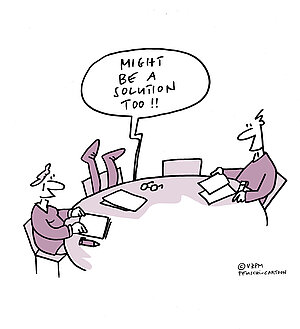Resourcefulness
Definition
Resourcefulness is the ability to apply various techniques and ways of thinking to defining, analysing, prioritising, finding alternatives for and dealing with or solving challenges and problems. It often requires thinking and acting in original and imaginative ways and stimulating the creativity of individuals and the collective creativity of the team. Resourcefulness is useful when risks, opportunities, problems and difficult situations arise.
Purpose
The purpose of this competence element is to enable the individual to effectively handle uncertainty, problems, changes, limitations and stressful situations by systematically and continuously searching for new, better and more effective approaches and/or solutions.
Description
Resourcefulness is about making optimal use of what to work with. It is not just about creating something new; it also applies to making existing things work better, faster or cheaper. The individual acquires capable resources and foster an attitude of resourcefulness within the team to stimulate, evaluate and act upon ideas that can benefit the process, results or goals. Ideas must often be ‘sold’ to the team before they are accepted. A team atmosphere that is open to creativity and innovation is a prerequisite for acceptance. Others in the team will then often champion the idea and refine it so that it gains greater acceptance.
Resourcefulness is one of the prime competences for project success. Resourcefulness helps to overcome problems and motivates the team to work together in developing the idea into a workable solution. Creativity must be used with care in the project team, so that the focus on realising the agreed results of the project is not lost. Conceptual and analytic techniques are also of utmost importance to deal with the information overflow that many projects and organisations face. Being able to extract, present or report the right information in a timely manner is crucial for success.
Key competence indicators
Stimulate and support an open and creative environment
The individual creates a work environment that encourages people to share their knowledge and contribute their ideas and opinions. To stimulate and support creativity and innovation, the individual needs to be open to original and imaginative ways to overcome obstacles. These ways may include new products, processes or procedures or could involve revising specific tasks or roles and responsibilities. The individual can make others feel they are welcome to express themselves, so that the project can benefit from their input, suggestions, ideas and concerns. This is necessary as a means of benefiting from others’ knowledge and experience. Openness is important as in every project professionals with various backgrounds and abilities have to work together. Most of the team members have an area of expertise where they are more knowledgeable than the individual. The relationships in the team are built on mutual respect, trust and reliability. So the individual should regularly ask people for their input and show willingness to understand and possibly adopt their ideas. Of course there is a time and place for everything, so the individual should also make clear when there is time for creative input and when not.
Measures
- Encourages people to share their knowledge and contribute their opinions
- Stimulates and supports creativity when appropriate
- Uses and stimulates original and imaginative ways to overcome obstacles
- Seeks input from others and shows willingness to consider and/or adopt their ideas
- Considers the perspectives of others
Apply conceptual thinking to define situations and strategies
Every project is a unique effort to create something new. Except in the most simple projects, this requires the abilities of abstraction and conceptualisation, that is, of breaking down or reducing the subject in question (be it an outcome, plan, requirement, risk, situation or problem) into smaller parts and integrating these into new and useable ideas. The individual must apply conceptual thinking and also leverage able team members. Conceptual thinking also means bearing in mind that problems regularly have multiple causes that relate to each other within a general context, and that different ways of solving problems have different effects on other parts, both in and outside the project.
Measures
- Uses or promotes conceptual thinking when appropriate
- Knows that problems often have multiple causes and that solutions often have multiple effects
- Applies systemic thinking
Apply analytic techniques to analysing situations, financial and organisational data and trends
The individual is able to analyse (or delegate the analysis of) complex situations or problems and find solutions and alternatives. The individual can also analyse and derive useful information and trends from complex sets of data and present or report the findings clearly. Analytical dexterity means having different methods available for detecting a problem’s actual causes and implementing or proposing the correct measures to solve it.
Measures
- Applies various analytic techniques
- Analyses problems to detect causes and possible solutions
- Analyses complex sets of data and extracts relevant information
- Clearly reports and presents data conclusions, summaries and trends
Promote and apply creative techniques to find alternatives and solutions
Creative techniques should be used to identify solutions. These techniques can be divided into ‘diverging’ techniques and ‘converging’ techniques. When problems arise, the individual needs to judge whether a creative approach is appropriate or not. Where a creative approach is appropriate, the individual needs to decide which methods to use.
After the problem or issue is defined (possibly by using conceptual thinking and/or analytic techniques) there follows a diverging creative stage, to gather possible solutions. A brainstorming session may be appropriate, where members of the team and others in the organisation who might be able to contribute meet to have their ideas captured. Other much-used techniques include mind mapping, storyboarding, visualising, etc. Whatever method is used in finding a creative solution, it involves looking at the issue from different perspectives, combining tools, knowledge, common sense, intuition and experience and applying them.
In the following, more analytic, converging stage, possible solutions and their effect on the problem or issue in question are analysed. Converging techniques include weighted selection, force-field analysis, etc. The most promising ideas are then further refined and finally the best concepts/solutions are chosen.
Measures
- Uses creative techniques when appropriate
- Applies diverging techniques
- Applies converging techniques
- Engages multiple views and skills
- Identifies interdependencies
Promote a holistic view of the project and its context to improve decision-making
To promote holistic views means considering a current situation in relation to the full context of the project, such as the enterprise strategies, concurrent activities and/or projects. The individual uses multiple perspectives to judge and deal with situations. The individual recognises the significance of details and can separate the details from the bigger picture. The individual understands the connection between the situation and its context and can make or promote decisions based on understanding of a wide array of influences, interests and possibilities. The individual is also able to explain these holistic views to others, both inside and outside the project.
Measures
- Demonstrates holistic thinking and an can explain the bigger picture
- Uses multiple perspectives to analyse and deal with the current situation
- Makes connections between the project and the larger context and takes appropriate action


